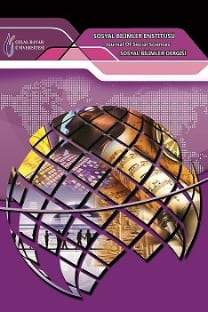ANGELA CARTER’IN YENİ HAVVA’NIN ÇİLESİ ADLI ROMANINDA GROTESK BEDENLER VE MEKANLAR
Yeni Havva’nın Çilesi, grotesk, fazlalık, insan-ötesi
GROTESQUE BODIES AND SPACES IN ANGELA CARTER’S THE PASSION OF NEW EVE
The Passion of New Eve, grotesque, excess, posthuman,
___
- BAKHTIN, MIKHAIL (1965), Rabelais and His World. Trans. H. Iswolsky. Indiana UP, Bloomington. CARTER, Angela (1982), The Passion of New Eve. Virago, London. DESCARTES, René (1995). Discourse on the Method and the Meditations. Trans. F. E. Sutcliffe. Penguin, London. GATENS, Moira (1996), Imaginary Bodies: Ethics, Power and Corporeality. Routledge, New York and London. MCAULEY, Alex (2008), “Surfing the Interzones: Posthuman Geographies in Twentieth Century Literature and Film.” Diss. U of North Carolina at Chapel Hill. MERCHANT, Caroline (1989), Ecological Revolutions: Nature, Gender, and Science in New England. U of North Carolina P, Chapel Hill. RUSSO, Mary (1994), The Female Grotesque: Risk, Excess and Modernity. Routledge, New York and London. THOMPSON, D (1997), The End of Time: Faith and Fear in the Shadow of the Millennium. Minerva, London.
- ISSN: 1304-4796
- Yayın Aralığı: Yılda 4 Sayı
- Başlangıç: 2003
- Yayıncı: Manisa Celal Bayar Üniversitesi
CENGİZ AYTMATOV'UN DİŞİ KURDUN RÜYALARI ROMANINDA ÇEVRE FELAKETİ
NATURAL RADIOACTIVITY OF THE COASTLINE OF ÇEŞME-İZMİR ABSTRACT
MANİSA ATMOSFERİNDE ÖNEMLİ ALLERJENİK POLENLER
Aykut GÜVENSEN, Ulaş UĞUZ, Ece BULUŞ, Nedret ŞENGONCA TORT, Aylin EŞİZ DEREBOYLU, Levent ŞIK
ANGELA CARTER’IN YENİ HAVVA’NIN ÇİLESİ ADLI ROMANINDA GROTESK BEDENLER VE MEKANLAR
BIOLOGICAL TREATMENT OF SOME ESSENTIAL METALS BY USING CHLORELLA VULGARIS
ÇERNOBİL DUASI”NDA, ANLATI KAHRAMANLARININ FELAKET KARŞISINDAKİ GERÇEK/GERÇEKÜSTÜ TUTUMLARI
PERCEPTION OF NATURE AND THE LANGUAGE OF IMPERIALISM IN RUDYARD KIPLING’S THE JUNGLE BOOK
CENGİZ AYTMATOV’UN HİKÂYE VE ROMANLARINDA ÇEVRE DUYARLILIĞI
UPTAKE OF SOME NON-ESSENTIAL METALS BY THE ALGA CHLORELLA VULGARIS ABSTRACT
